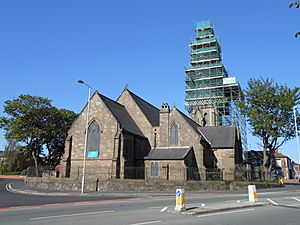St Paul's Church, Seacombe facts for kids
Quick facts for kids St Paul's Church, Seacombe |
|
|---|---|

St Paul's Church, Seacombe, during reconstruction of the spire
|
|
| Lua error in Module:Location_map at line 420: attempt to index field 'wikibase' (a nil value). | |
| OS grid reference | SJ 323 908 |
| Location | Church Crescent, Seacombe, Wallasey, Wirral, Merseyside |
| Country | England |
| Denomination | Anglican |
| Churchmanship | Evangelical |
| Website | St Paul, Seacombe |
| History | |
| Status | Parish church |
| Dedicated | 12 October 1847 |
| Architecture | |
| Functional status | Active |
| Heritage designation | Grade II |
| Designated | 12 March 2009 |
| Architect(s) | John Hay |
| Architectural type | Church |
| Style | Gothic Revival |
| Groundbreaking | 1846 |
| Completed | 1891 |
| Specifications | |
| Spire height | 110 feet (33.5 m) |
| Materials | Sandstone, slate roofs |
| Administration | |
| Parish | St Paul, Seacombe |
| Deanery | Wallasey |
| Archdeaconry | Chester |
| Diocese | Chester |
| Province | York |
St Paul's Church is an active Anglican church located in Seacombe, Wallasey, England. It is a parish church, which means it serves a local community. The church is part of the Diocese of Chester. It is also recognized as a Grade II Listed building, meaning it is an important historical building.
Contents
History of St Paul's Church
Before the 1800s, Seacombe was mostly farmland. But in the 1840s, rich business people from Liverpool started building big houses there. St Paul's Church was built early on, to serve both the old farming community and the new residents.
The church stands on a high spot, looking over the ferry terminal. It was built between 1846 and 1847. The architect, John Hay from Liverpool, designed it. The church officially opened on October 12, 1847. Its tall spire was finished in 1849.
Over the years, the church grew. A south aisle (a side section) was added in 1859. In 1891, a north aisle, a special chapel called the Lady Chapel, and a west gallery (a balcony inside) were built.
During the Second World War, bombs damaged the front part of the church. This section had to be rebuilt. Later, in the mid-1900s, the spire became unsafe. The top 20 feet (about 6 meters) were removed. A new top, shaped like a crown of thorns, was made by a company called Cammell Laird.
More recently, in 2013 and 2014, the spire was taken apart. A strong stainless steel frame was put in place. The original stones were used again for the lower part of the spire. New stones were added to the very top to make it as tall as it was originally.
Church Design and Features
Outside the Church
St Paul's Church is built from sandstone with roofs made of Welsh slate. Its design looks like buildings from the 1300s. The church has a long main area called a nave with seven sections. There's a south aisle with seven sections and a porch. There's also a north aisle with six sections.
The church also has a north transept (a part that sticks out, making the church look like a cross). This transept holds the Lady Chapel. There's a two-section chancel (the area around the altar) and a north vestry (a room for clergy). A tall steeple stands at the northwest corner.
Around the church, you can see buttresses (supports built into the walls). Between these supports are tall, pointed windows. These windows have fancy stone patterns called tracery. The window at the east end has three parts, and the west window has four parts with a small, three-leaf shaped window above. Along the roof of the south aisle, there are small, gabled windows called dormers. The south porch has a pointed roof and narrow windows.
At the west end, a hexagonal (six-sided) stair tower leads up to the west gallery inside. The steeple has a three-part tower and a spire. The tower has a door on the west side. At the top of the tower are pointed decorations called pinnacles. The very top of the spire is the new material added during its recent rebuilding.
Inside the Church
The inside walls of St Paul's Church are plastered. Between the nave and the side aisles are five-section arcades. These are rows of arches supported by thick columns called piers. The tops of these columns, called capitals, are carved.
The nave roof has a special design with criss-crossing wooden beams. It is held up by carved stone supports called corbels, which are shaped like angels. The arch leading to the chancel is decorated with moulding. The chancel ceiling is made of painted panels. Around the lower part of the chancel walls, there is a painted dado (a decorative panel).
The stone pulpit (where sermons are given) is to the left of the chancel arch. It has marble columns and is carved with symbols like Alpha and Omega and the IHS Christogram (symbols related to Jesus). The sandstone baptismal font (used for baptisms) was made in the early 1900s. The church also has an organ built by Henry Willis & Sons.
Why St Paul's Church is Important
St Paul's Church was officially named a Grade II Listed building on March 12, 2009. Grade II is the most common level of listing. It means a building is "nationally important and of special interest."
One reason the church is important is its history. It served as a landmark for ships sailing on the River Mersey during the mid to late 1800s. This shows its special role in the area's history and its connection to the river.
See also
- Listed buildings in Wallasey

